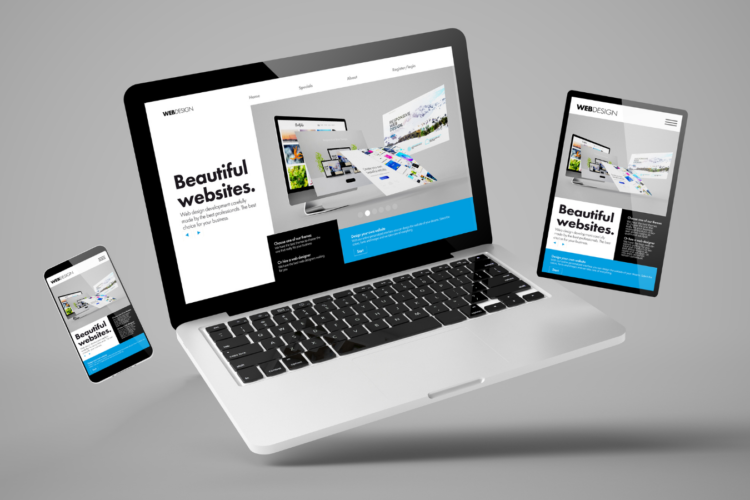Let’s be real, most B2B websites are pretty boring. They’re full of jargon, stock photos, and generic messaging that could apply to any company. But yours doesn’t have to be one of them!
Your website is like your online handshake – it’s the first impression you make on potential clients. And just like in real life, you want to make that handshake strong, memorable, and genuinely you. For B2B companies, creating a cohesive brand identity through website design is essential to establish credibility, foster trust, and differentiate from competitors.
So how do you build a website that not only reflects your brand’s unique personality but also gets results? It all starts with your story.
1 – Your Story: The Heart of Your Website
Think of your website as a digital campfire. You’re gathered around with your ideal clients, sharing stories, building relationships, and ultimately, doing business. But for those stories to resonate, they need to come from a person-to-person perspective.
Your brand story is the foundation of everything you do, including your website. It’s about who you are, what you stand for, and why your customers should care. It’s the unique combination of your values, your mission, and the special sauce that makes you different from everyone else.
- Homepage Messaging: Your homepage should immediately convey what your company does and how it can help solve your customers’ problems. Be clear and concise!
- Content Tone and Style: Maintain a consistent tone of voice across all written content. Whether formal, conversational, or technical, the tone should reflect your brand’s personality and be consistent in all sections of the website.
- Taglines and Slogans: Use taglines and slogans that encapsulate your brand’s essence. These should be prominently displayed and used consistently.
2 – Telling Your Story Through Design
Your website design is like the stage for your story. It should set the mood, create an atmosphere, and draw your audience in. Think about the colors, fonts, images, and layout – all of these elements should work together to tell a cohesive story that reflects your brand’s personality:
- Color Palette: Choose a color palette that reflects your brand’s personality and stick to it across all pages. Consistent use of colors enhances brand recognition.
- Typography: Select a set of fonts that align with your brand’s tone and ensure they are used consistently across all content.
- Imagery: Use high-quality images that resonate with your brand’s message. Whether it’s product photos, team images, or infographics, consistency in style and quality is key.
But remember, design isn’t just about looking good. It’s also about functionality. Your website should be easy to navigate, with clear calls to action that guide visitors towards your goals. A seamless and intuitive user experience can significantly enhance brand perception.
- Navigation: Ensure that the website is easy to navigate with a clear structure and logical flow. Consistent – but sparing – use of navigation elements across all pages help users find information quickly and easily.
- Responsive Design: With a significant portion of B2B research happening on mobile devices, ensure that your website is fully responsive. A consistent user experience across all devices reinforces brand reliability.
- Speed and Performance: A fast-loading website not only improves user experience but also reflects positively on your brand. Regularly optimize your site to ensure it performs well.
3 – Content That Connects
The words on your website should tell a compelling story, with your customer as the central character. They should speak directly to your target audience, using their language and addressing their specific needs. Avoid jargon and buzzwords, and focus on showcasing how you guide your customers to success and building trust.
Remember, people buy from people they know, like, and trust. Your website content should aim take visitors through a journey to get them there.
- Customer-Focused Language: Use pronouns like “you” and “your” to directly address the reader, making them the center of your brand’s story.
- Success Stories: Highlight client stories and testimonials that showcase your brand’s impact. Consistent formatting and presentation of these elements can enhance credibility and trust.
4 – Marketing That Matters
Your website isn’t just a pretty face – it’s a powerful marketing tool. By aligning your website with your overall marketing strategy, you can create a cohesive brand experience that drives traffic, generates leads, and ultimately, boosts sales.
Here are some tips for implementation and maintenance:
- Brand Guidelines: Develop comprehensive brand guidelines that outline all aspects of your visual and messaging strategies. Ensure all team members and stakeholders adhere to these guidelines.
- Regular Reviews: Schedule regular reviews of your website to identify any inconsistencies and make necessary adjustments.
- Feedback Mechanism: Implement a feedback mechanism to gather insights from users about their experience. Use this feedback to refine and improve the website.
Conclusion
A cohesive brand identity through B2B website design is crucial for establishing credibility, fostering trust, and differentiating from competitors. By focusing on consistent visual design, unified messaging, seamless user experience, and integrated branding elements, B2B companies can create a powerful online presence that resonates with their target audience. Regular audits and adherence to brand guidelines ensure that the website remains aligned with the company’s evolving identity, driving long-term success and growth.
Following these guidelines will help you build a B2B website that feels like you and helps you connect with the right people.


